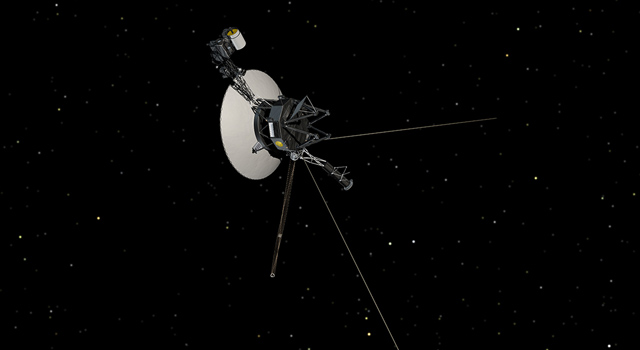News | March 1, 2001
Evidence Seen For Wet Past on Ganymede, Jupiter's Largest Moon

Bright, flat terrain in long swaths on the surface of Jupiter's icy moon Ganymede may testify that water or slush emerged there about a billion years ago, say planetary scientists who have combined stereo images from NASA's Galileo and Voyager missions to examine provocative features on that moon.
This bright terrain, long since frozen over, lies uniformly in troughs about one kilometer (a little over a half mile) lower than Ganymede's older, darker, cratered terrain.
Ganymede is the largest moon in the solar system and larger than the planet Mercury. The roles that volcanism and various forms of tectonics have played in molding its complex topography have been hotly debated over the years. But the newly created images, taking advantage of the large quantity of Voyager images and the higher resolution of Galileo's, point to volcanism as the main impetus behind the troughs.
"What we think we're seeing is evidence of an eruption of water on the surface of Ganymede," said Dr. William B. McKinnon, professor of Earth and planetary sciences at Washington University in St. Louis and co-author of the study published in Nature on March 1, 2001. "We see these long, smooth troughs that step down up to a full kilometer. They're really very much like rift valleys on the Earth and they're repaved with something pretty smooth. The material in the troughs is more like terrestrial lava in terms of its fluidity than relatively stiff glacial ice." He said the material is banked up against the edges of the walls of the trough and appears to have been more fluid than solid ice would have been, even if it were relatively warm ice. These features support the idea that they were created by volcanism.
The report's other authors are Dr. Paul Schenk of the Lunar and Planetary Institute, Houston, Texas; Dr. David Gwynn of the University of California, Los Angeles; and Dr. Jeffrey Moore of NASA's Ames Research Center, Moffet Field, Calif. Images from the report are available online from NASA's Jet Propulsion Laboratory, Pasadena.
The researchers used stereo imaging -- a method where three-dimensional objects are reproduced by combining two or more images of the same subject taken from slightly different angles -- to reconstruct the physical topography of Ganymede's terrains. Maps were then generated from the stereo images. "This is a new kind of stereo topographical information over hundreds of kilometers across Ganymede," McKinnon said. The images provide new clues about what happened on Ganymede long ago and how that moon reworks its older, darker material.
One trough extends an estimated 900 kilometers (about 600 miles), the approximate distance between St. Louis and New Orleans. "The long trough is probably a billion years old, but it's actually one of the younger volcanic features," McKinnon said. "It's the last gasp of the process that made the bright terrain."
According to McKinnon, the geological explanation for such long lanes of flatness is that they occurred by the extending and opening up of Ganymede's crust. And then that portion of the crust became flooded with some sort of lava. The high-resolution Galileo images show that material that flooded the lanes is "no less liquid than a slush," said McKinnon. "But it is not glacial ice, which would have big moraines and big round edges like a flowing glacier does."
Moreover, the images reveal depressions that resemble volcanic calderas along the edges of the bright terrains. On Earth, calderas are large, more-or-less circular craters usually caused by the collapse of underground lava reservoirs. "The caldera-like features make a pretty good circumstantial case for volcanism causing this topography," McKinnon said. "We think these particularly bright terrains were formed by volcanism, which means that most or all the other bright terrains started out this way, and became fractured or grooved over time through tectonic forces."
Galileo has been orbiting Jupiter since 1995. Its 12 scientific experiments have enhanced researchers' understanding of Jupiter's atmosphere, large moons and vast magnetic field. It carried the first atmospheric probe to enter Jupiter's atmosphere. In other firsts, it was the first mission to discover a satellite of an asteroid (Ida's satellite Dactyl), the first to go into orbit around Jupiter, the first to make a close flyby of an asteroid (Gaspra), and the first to provide direct observations of a comet hitting a planet (Shoemaker-Levy 9). Galileo has also provided extensive information about active volcanism on the moon Io and the possibility of a subsurface ocean on the moon Europa. Later this year, it will make close approaches to the moons Callisto and Io.
The Voyager 1 and Voyager 2 spacecraft each passed near Jupiter in 1979 and then explored more distant parts of the solar system. The Jet Propulsion Laboratory, a division of the California Institute of Technology in Pasadena, manages the Galileo and Voyager missions for NASA's Office of Space Science, Washington, D.C.
News Media Contact
Washington University/Tony Fitzpatrick (314) 935-5272
JPL/Guy Webster (818) 354-6278
NASA Ames Research Center/Kathleen Burton (650) 604-1731
NEWS RELEASE: 2001-046
